#the same tv show but produced in america
Text
i understand that to the average audience member it probably doesn't matter, but as a japanese person who doesn't get much japanese rep in america it makes me Very Happy when i see fanart of anime characters looking Visibly Asian
#like ik that most people just draw them as like “default”#which is fair!!#bc obviously anime is from japan#so a character's japanese-ness isn't pronounced in the way that it would be in#say#the same tv show but produced in america#so a lot of people don't view anime characters of japanese#more as just lacking any sort of race#since japan is hella mono-ethnic and therefore doesn't really factor in race as having conscious impact on characterization#that all makes sense and i know it!!#that being said#it makes me so so happy when i see a character whos eyes are visibly slanted the way mines are#or have flatter more asian facial structure the way mines does#when az rambles
0 notes
Note
So one thing that irks me about discussions of the NCR is the idea that "they're flawed because they're trying to be America again. And Being Too Much America is what caused the War" without differentiating between the vast buildup of Nuclear Weapons and Geopolitical tensions, versus, like, being a republic and having a large-scale central state.
What's your thoughts?
I think the NCR circa New Vegas is textually intended to be repeating the USA's downward spiral. They're in the process of recreating the core dynamics of pre-war America- overconsumption of resources driving imperialist expansion, capture of the government by moneyed interests, and a prolonged conflict with a peer power that's suffering under similar expand-or-die pressures- but they're constrained from a one-to-one recreation mainly by the fact that they're working with a post-apocalyptic resource base, with the scraps left over from the last people who went down this path. Peanuts compared to the Sino-American war, but likely as close to that situation as the post-war-world is logistically capable of producing.
You see bits of this from the NCR perspective all throughout the game. There Stands the Grass is propelled by projections of incipient famine in the NCR due to rapid population growth, and you see the beginnings of this in Flags of Our Foul-Ups- O'Hanaran was sent to the Army by his family to lessen their food burden. Chief Hanlon's very first line is about how the NCR is overtaxing most sources of freshwater within the core territory, and he recounts how tiny groups of settlers backed by NCR logistics were able to take and hold a well in Baja against scores of locals; IIRC there's a cut event at Camp Golf itself where you'd see NCR rangers doing the same thing to Mojave locals encroaching on their water supply. The White Wash demonstrates that the NCR's sharecropping setup in outer Vegas operates at the expense of the locals, who can only get the water they need to support their own crops via subterfuge. If you assume that Heck Gunderson's underhanded Brahmin-farming empire in Beyond the Beef is supposed to parallel the real-world problems with the sustainability of beef farming, you start to get a sense of where all of that water is going and what structural problems (Heck Gunderson) might be in the way of allocating those resources more sustainably. There are likely more examples of this storm on the horizon that I'm forgetting.
As a result of all this, there's a level on which I think introducing the Tunnelers in Lonesome Road as a dangling White-Walker style Looming Apocalyptic Reset Option hanging over the west coast was gratuitous, not because it's Avallone grinding his axe with the idea of society rebuilding, but because it's simply redundant with the political situation already depicted in the base game- If you want the NCR to have collapsed by a future installment, just establish that they weren't able to put the brakes on in time and devolved into a completely dysfunctional oligarchy that collapsed under its own weight!
(Now, as a final note, one thing preventing me from fully committing to this take is that we honestly don't have a fantastic sense of what day-to-day life looks like for the average citizen in the NCR heartland, which I feel is kind of important. Because if the textual situation is supposed to be that the resource crisis is due to misallocation due to interests capturing the government, I like that a lot better than if the situation is genuinely intended to be that there are Just Too Many Goddarn People, because that's like. Lazy and Malthusian and leads to the usual ugly conclusions pretty quickly. More and more it's looking like the upcoming Fallout TV show is leaning into the recent decline of the NCR as a plot point, so, uh, fingers crossed they stick the landing when it comes to fleshing that out?)
#fallout#fallout new vegas#NCR#new california republic#ask#asks#thoughts#meta#sorry for the delay in responding- getting back into a fallout mood due to the show#fnv
72 notes
·
View notes
Text
On the subject of Dinosaur Documentaries...
So Life On Our Planet dropped a few days ago, another installment of this seeming boom of these kind of shows since Prehistoric Planet last year, and it got me thinking about this whole little niche genre.
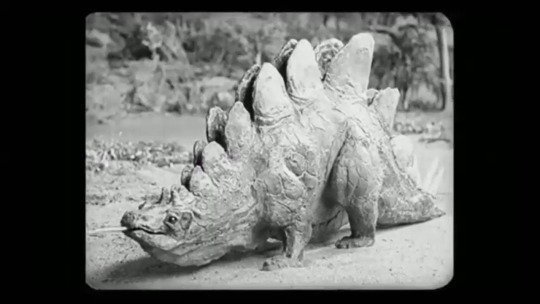
The very first "Paleodoc" was released in 1922, made by the Carnegie Museum of Natural History to educate museum goers on how the fossils they saw were collected and prepared. This began the format I like to call the "Talking Heads" Paleodoc which is mainly in the form of interviews or narration over actual footage of Paleontologists at work with the occasional "Live" Dinosaur for visual aid. These are by far the most common form of dinosaur documentary you'll find, even today, mainly because they're cheap to produce and fit in the general style of most science documentaries.
For many decades throughout the 20th century, Paleodocs were pretty rare. They would pop up time to time, and with the sudden influx of attention they got after Jurassic Park, we got some really good ones. Yet they were all the same Talking Head types. What really changed the game was the good ol Magnum Opus of the field: Walking With Dinosaurs.
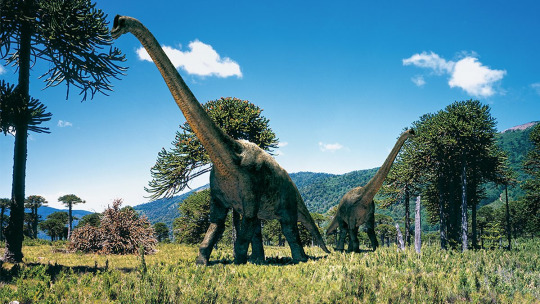
WWD pioneered the second type of Paleodoc I believe to exist, which are the "In Their World" Paleodocs. These are different in the fact they focus almost entirely on the live visual aids, with the human presence being limited to narration or brief pauses for context. They're meant to simulate the modern nature documentary, like Planet Earth, that focus more on showcasing animal behavior with state of the art filming techniques than being a source of in-depth science.
The success of WWD cannot be overstated, and I have to say I do find the In Their World format a lot more engaging and easier to connect with. They portray the wonder of prehistory spectacularly, letting audiences get emotionally connected in the animal characters the story creates, even if this has lead to criticisms of anthropomorphism. These programs also almost always use real footage of modern day earth for their prehistoric creatures to roam on, which I'm sure is very sad for the people who want to see their favorite dead plants on screen.
The Walking With... series would expand into sequels and spin-offs and Nigel Marven, and other companies like Discovery would jump on the bandwagon and release their own takes on the concept, but by the mid 2010s the format had basically died out. We'd get one or In Their World style doc every few years until we just didn't get anything. Outside of the occasional TV special that reused When Dinosaurs Roamed America footage, it was empty.
It took until Disney's Live Action remake of The Lion King of all things for that pendulum to start swinging again. Seeing those expressionless CGI cats got Jon Favreau thinking about how he could use this technology and the talented people behind it to make something really cool, and we got Prehistoric Planet.
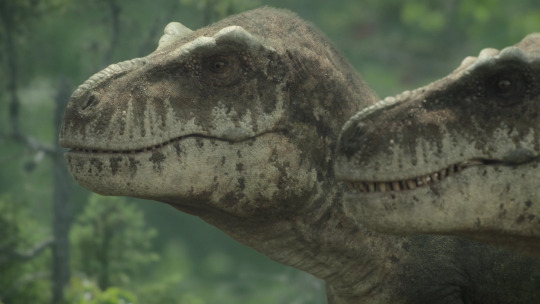
And, in a repeat of Walking With Dinosaurs, we're seeing more of these In Their World type shows. The original guys behind WWD are even making a comeback with their own series, Surviving Earth. Plus even more little hints and rumors of massive incoming projects from overexcited paleontologists trying not to break their embargo.
It looks like the 2020s will be another resurgence in these types of spectacle Paleodocs, and while a good ol Talking Head will always be there, I can't help but get excited for these animated spectacles and all the weird and wonderful ways they flash those visual aids across our TV screens.
162 notes
·
View notes
Text
ELVIS' DEBUT ON TV — 📺
[CBS] The Dorsey Brothers 'Stage Show'
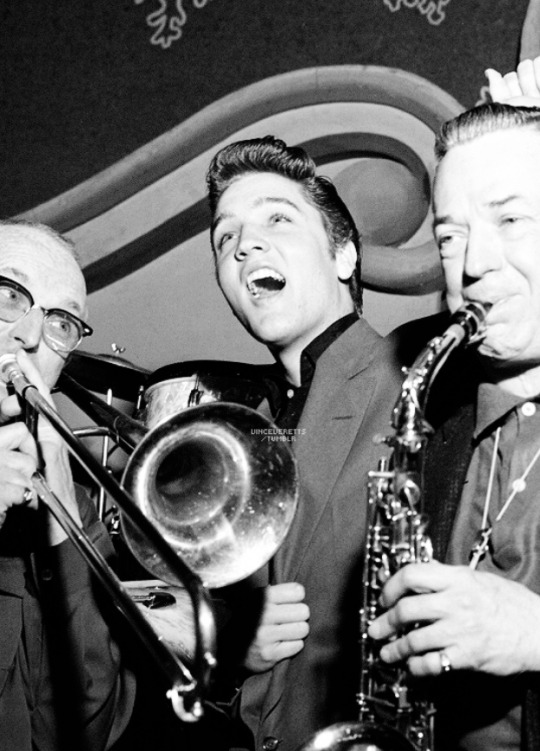
Elvis with Tommy and Jimmy Dorsey at CBS Studio 50, New York, March 17, 1956 [that would be Elvis' 5th appearance on their TV show, out of 6 total.].
------------------------------------------------------------------------------------------------
By December 1955 Elvis had still not made an appearance on national television. His manager Colonel Tom Parker negotiated a deal through Steve Yates with CBS's "Stage Show" for four appearances on the show in January 1956 at $1,250 each and an option for two more at $1,500 each.
On the January 28, 1956, Elvis was broadcast for the nation for the very first time, performing "Shake, Rattle and Roll", "Flip, Flop and Fly" and "I Got a Woman".
youtube
[ABOVE: the January 28th 1956 FULL PERFORMANCE]
On Elvis' first appearance on American television, Bill Randle, one of the most influential disc jockeys of the time, was the man who actually presented Elvis Presley to the nation. He said:
"We'd like at this time to introduce to you a young fellow, who like many performers, Johnnie Ray among them, come up out of nowhere to be overnight very big stars. This young fellow we met for the first time while making a movie short*. We think tonight that he's going to make television history for you. We'd like you to meet him now - Elvis Presley. And here he is!"
— Bill Randle, Disc Jockey, the man presenting Elvis Presley to America for the first time. January 28, 1956.
After this, things would never be the same, specially the society. Such a good beginning for a year, that special day in a January month! ♥
------------------------------------------------------------------------------------------------
🎞️THE SHORT-FILM THAT NEVER SAW THE LIGHT OF DAY (for the general public... at least until now...)
The movie short Bill Randle referred to during his introduction to Elvis was "The Pied Piper Of Cleveland - A Day In The Life Of A Famous Disc Jockey" a short film made by Universal pictures about Bill Randle himself. Filmed on October 20th, 1955, at a concert in Brooklyn High School, Cleveland, it featured the stars Bill Haley & The Comets, The Four Lads, Pat Boone, plus the addition of a little-known Elvis Presley.
The original forty-eight-minute film was supposed to be cut down to a twenty-minute "short" for national distribution, but never made it that far. We're in 2024... 69 years went by since this shortcut was produced but the movie remains unreleased.
There is some dispute over whether or not this film actually exists, although it's said it was shown publicly, albeit only once in Cleveland, and excerpts were also aired on a Cleveland television station in 1956. Marshall Lytle, bass player for Bill Haley's Comets, corroborates the existence of the film in his memoir, "Still Rockin' Around the Clock", but he makes the unsubstantiated claim that Colonel Tom Parker, Presley's manager, bought the film and destroyed the existing copies. According to historians, tho, DJ Bill Randle, before his death in 2004, sold the rights to the film to PolyGram (it has been reported that Universal Studios has the negatives of the film in its vaults).
Much uncertainty about this short film, but can you imagine this film being release in Elvis' birthday centenary celebration? We watched, and listened, on Elvis' 89th birthday a few days earlier this year, to them playing during his birthday celebration at Graceland the original "That's All Right" record as it was cut at Sun Records studio in 1954, so who knows? There's always rare things surfacing here and there, so... we better keep our hopes this Bill Randle's 1955 movie, with some new 'baby Elvis' footage, will be release any day now [such as we know there's 'Elvis On Tour' and 'Elvis: That's the Way It Is' never seen before footage coming our way, as confirmed by the "Elvis" 2022 biopic's film director, Baz Luhrmann — finally! We hope it will be released soon].
------------------------------------------------------------------------------------------------
But enough daydreaming... Back to Elvis' 1st television appearances.
After the premiere on America's television on January 28th, 1956, Elvis would do five more appearances on 'The Dorsey Brothers Stage Show" for the next eight weeks. Those would take place on February 4, February 11, February 18, March 17 and March 24th, 1956.
------------------------------------------------------------------------------------------------
February 4th, 1956 | "Baby Let's Play House" and "Tutti Frutti"
youtube
youtube
------------------------------------------------------------------------------------------------
February 11th, 1956 | "Blue Suede Shoes" and "Heartbreak Hotel" *
youtube
youtube
* This is a special arrangement for 'Heartbreak Hotel', so good! Jazzy, dramatic, really rarity. I loved this! ♥
------------------------------------------------------------------------------------------------
February 18th, 1956 | "Tutti Frutti" and "I Was The One"
youtube
youtube
------------------------------------------------------------------------------------------------
March 17th, 1956 | "Blue Suede Shoes" and "Heartbreak Hotel" *
youtube
youtube
* This is the usual arrangement for the "Heartbreak Hotel" song. On February 11th, 1956, Elvis performed this same song onstage of 'The Dorsey Brothers Show' but it sounded something more… dramatic (I guess it matched the lyrics after all, but I love the usual arrangement better yet).
------------------------------------------------------------------------------------------------
And the last one... the 6th appearance on 'Dorsey Brothers Stage Show':
March 24th, 1956 | "Money Honey" and "Heartbreak Hotel" | [FULL PERFORMANCE]
youtube
------------------------------------------------------------------------------------------------
We can see how on those first TV shows Elvis still looks quite shy. Although he moves the usual lot, he doesn't flirt with his audience as much as he would on the upcoming TV appearances (and throughout his life, actually). It's funny how he grew comfortable with being in front of the cameras so fast tho. As his photographer Wiliam Speer said, "I guess you must really like being photographed."
------------------------------------------------------------------------------------------------
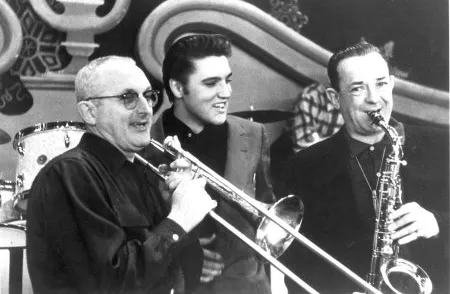
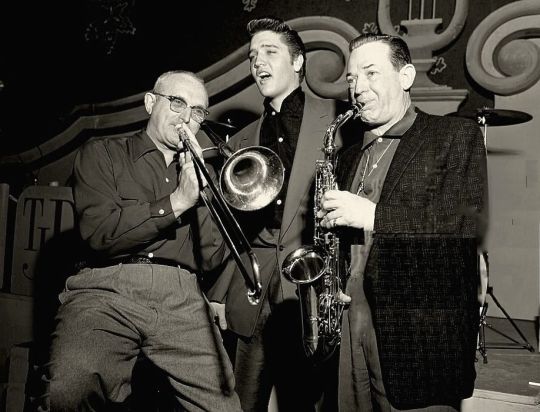
Elvis with Tommy and Jimmy Dorsey at CBS Studio 50 in New York, on March 17, 1956. That would be Elvis' 5th appearance on their TV show. 'The Dorsey Brothers Stage Show' (CBS) was the place Elvis debut in his TV appearances, on January 28th 1956. He would appear on the show for 6 times total, from January to March 1956. ♥
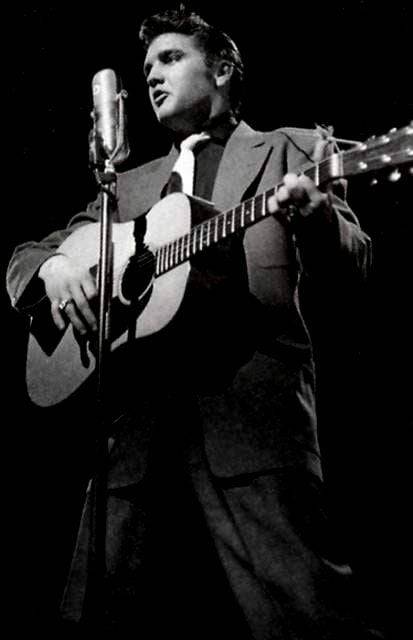
Performing on the 'Dorsey Brothers Stage Show' at the CBS Studio 50, New York City, on March 24th, 1956. His 6th and final appearance on the show.
------------------------------------------------------------------------------------------------
EDIT: THE BLUE MOON BOYS


I hate it when I forget to mention such important, trivial, facts — and this shouldn't be footnote info and I feel guilty it is now but I forgot mentioning — The Blue Moon Boys. I love them so much! I watch those footage looking at them as much as I look at Elvis.
Like, I love Bill Black's energy onstage! I love him hollering, vibing to their sound, as loud as Elvis (on occasion). I love how he seem to love chewing gum (Bill is chewing gum in some of those footage), because it makes me look at the Blue Moon Boys and Elvis as a unit, real close friend who look alike, just how it should be. We know although EP for obvious reasons can't chew gum while singing, he loooooved gum and kept this - should I say "habit?" - throughout his life. It's sounding silly what I'm saying, I know, but I think this Elvis habit in fact date from back when he was rocking onstage with Bill, Scotty and DJ Fontana and it makes my heart warm how close and similar they seem to be, as friends, real friends. Bill is actually said to be the one cheering the crowds onstage when they first begun performing, when Elvis was still learning how to be the great leading man he became. When EP was still learning how to act onstage, how to manipulate the audience, creating the mad passionate reactions he learned to create whenever he wanted, Bill was the one heating things up, joking with the audience, cheering, hollering. Bill is amazing! His energy is intoxicating, and we can see it clearly on those first TV appearances performances. ♥
--
I also love how hot Scotty Moore looks! I kinda laughed thinking 'Oh my goodness' ... So this thing about rock and roll bands always having hot vocalists and hot guitar players as a rule, it looks like it all started from the 50s with EP and Scotty! (really, at least the singer and guitar player in most rock bands are hot AF, am I lying? *lol*). I have a thing for Scotty... When he smiles at times on those footage, I'm like: 🤤🥹🥴🫠 And I also love how he's elegant but at the same time menacing looking holding and playing his guitar like the guitar hero he was. Really, if you haven't yet, do yourself a favor and read Scotty's book "THAT'S ALL RIGHT, ELVIS: The Untold Story of Elvis' First Guitarist and Manager, Scotty Moore", by Scotty as told to James Dickerson (1997). Scotty's life story is fascinating and as interesting as Elvis'. ♥
--
And last, but never least, I love how together, calm and concentrated DJ Fontana looks. Ok, unfortunately being the drummer has it's disadvantages. We can't see DJ Fontana as much as we see the other boys onstage, but I listen to the songs until the very last minute and it's amazing how the music always has the closing, the important and dramatic ending, done by DJ's talented hands. I love that guy. ♥
Elvis Presley and The Blue Moon Boys were the best rock and rollers! I love their energy together. As much as I adore 70s Elvis onstage, the TCB Band, the Sweets Inspirations and all, if I only had one performance of Elvis' I could attend, just one to choose, I would go for - undoubtedly - the 50s ones, when those guys, The Blue Moon Boys and Elvis, were playing together.
That's Rock and Roll royalty. ✨👑 ♥
------------------------------------------------------------------------------------------------
There you go. All the videos together so you can watch of them easily. ♥
#elvis for the first time on America television#imagine seeing this baby for the first time out of the blue and then watching him skyrocketing in less than a year...#and then testify as he only grew bigger and bigger and even when he's no longer walking in earth how people still love him#man how I wanted be an old lady just because i would have lived and breathed Elvis Presley 🥹#all i can do is imagine#elvis the king#elvis#elvis presley#the blue moon boys#bill black#scotty moore#DJ fontana#Youtube#elvis fans#elvis fandom#elvis history#50s elvis#tv history#tv shows
78 notes
·
View notes
Text
My Plan for the Upcoming Twilight TV Show so that it's actually Good
I heard recently that they're doing a Twilight TV show. The rights are out there at the very least. Who knows when it will happen and what network will produce it where, but it's going to happen.
But here's my thing - they're going to do it wrong if they do it the way I think they will, which is anything like the timeline of the Books/Movies. As a hardcore Twilight fan (yes I'll admit it, I spent a long time in fandom as a preteen, okay? It was my first online fandom and the first fanfiction that I wrote) I have Opinions(TM) about how to make the show in a way that would make it interesting. Stephanie Meyer had interesting ideas and I stand by this! There's a lot of untapped potential in the series and I think if they did it right it could be a really, really cool show! But there's not much going on if we just rehash the same events of the books over again at an episodic level.
No.
I present to you, not the TV show "Twilight", but the TV show "Cullens", which starts off with Carlisle Cullen as he has come to America when he finally starts to build his Coven.
This is NOT the story of whiny Bella Swan and her falling in love with Edward and becoming a vampire over 4 books or 5 movies, but rather the story of a man who has already spent over two centuries as a vampire, struggling because of his love for humanity as he finds purpose and meaning as he builds his family. We follow his story as he collects his coven.
We truly open on the show when Carlisle finds Edward dying of Spanish Influenza and decides to turn him for humanity's sake because he would die and because he as a man is lonely and this boy is so young, only 17, and Edward's mother begs him to do whatever he can to save her son and who knows, maybe Carlisle's been watching him and he sees him like a son already too. Maybe we get flashbacks to Carlisle with the Volturi for those 20 years he stayed with them in Italy back in the early 1700s, who knows. The fact of the matter is, that Carlisle is a doctor at the hospital where Edward is, and for whatever reason that we as an audience are compelled to understand in this first and important episode is Carlisle is finally done being alone and craves family and Edward resembles that for whatever reason, so Carlisle gives in and turns him. The next several episodes are an arc about their relationship as we deal with newborn Edward. We know how hard it is to adjust to being newly turned. After he calms down, Edward then has to confront his mortality and that of his family, we see him start to remember his family and confront those memories. More flashbacks to the Volturi as Carlisle explains what being a vampire is to Edward etc.
We follow the pair then as they travel around with the cover story that Edward is Carlisle's nephew. It's three years later when Esme enters the picture. What we know already is she attempted suicide and Carlisle turned her to save her - and that they have history since Carlisle treated her for a broken leg some ten years prior when she was 16 years old. Fast forward to now and she's gone through an abusive marriage where she ran away from her husband several times, most recently after getting pregnant, and has just lost her baby due to a lung fever. At her wit's end with all of it, Carlisle finds her after she jumps off a cliff attempting to end her life. They end up falling in love and getting married after she is turned. That's several episodes I'm sure. GREAT ARC. But Esme struggles with blood lust, which is a great transition into the conversation for what happens just a few years later with Edward...
We can tie more vampire politics into the show (especially the Volturi into it) when Edward goes through his Ripper phase when he decides he doesn't want to drink animal blood like Carlisle teaches him. The two fight but what can Carlisle do? Maybe there are other vamps around as well to cause extra drama. Who knows? It is a TV show, after all. He goes off on his own and that's a whole plot. I'm sure the network could find some interesting ways to make this dramatic for a few episodes and keep enough plot points alive. Add in some new OC's and side characters. Remember the Denali clan? When do they start being formed? There's not a lot of context on them, just that they're close with The Cullen's. Maybe we get some of their story and interaction here. Maybe Sasha (the original leader who was killed by the Volturi for creating an immortal child) reaches out to Carlisle at some point near the beginning and this is when they all become vegetarian vampires together before the whole Denali clan is formed too.
Fast forward to when that arc is resolved. Edward is back with Carlisle and Esme and the peace is back. Now, we get Rosalie... Now, the thing with Carlisle, is he doesn't turn people just to turn people. He's very moralistic. We learn that all the time about his character. I'm sure our little trio has traveled on from Chicago and is in New York where they encounter Rosalie Hale who was assaulted nearly to death by her husband and all his buddies. Carlisle is somewhat of a matchmaker here and hopes Rosalie and Edward can keep each other company for their immortal lives... it makes me wonder what episode and background we can throw into the show here. Did Carlisle know this girl in any other capacity? Why are his dad senses tingling about Rosalie anyway? That's gotta be an arc.
Anyway, turns out Rosalie is not only not interested in Edward, but she's only really interested in staying with the Cullens because being alone forever would get lonely, so she stays with them... but that's after her revenge arc because Rosalie Hale is a certified Bad Ass. She goes after her Fiance and all his Dude Bros and takes them all out, and I can just imagine her executing this flawlessly as a vamp. I do wonder if Edward reads her mind about her plans and asks if he can help her, though. Eventually, she gives in and it's Sibling Bonding(TM) at its finest. It's this bonding that convinces Rosalie to stay with the Cullens after all, and that's that.
Next, we get Emmett. Now, this is a fun one! Because we get Emmett who starts pining over the gorgeous Rosalie Hale when they move to this new place. I'm not sure it says where they are, but I digress. Do we have a bit of the Bella/Edward vibes here? Are there warnings of "don't let the human close"? Is this around the time when we've just had the Denali arc and are reminded of the human child being killed? Is Carlisle having flashbacks? What is the drama? Make it interesting, TV people! Is Edward mad that Rosalie is flirting back? Is it harmless? Who. Knows. -- But then, it doesn't matter because Emmett is getting mauled by a bear in the woods and... wait, why is Rosalie even there? Why does she even find him? Hmmm, seems like she's following him around protectively ;) well- whatever the reason and drama, Emmett is near dead and she saves him and brings him to Carlisle to be turned. The reactions of the coven... the reactions of the town, of his family, of his friends, the drama. Make it interesting, once again, people! This is TV gold! It's cliches and everything you want for TV, c'mon! And then, of course, since they were already practically in love already, they really can be together, but now they have to leave because Emmett is supposedly dead and the Cullens are complicit in that for some reason too perhaps. So they get out of dodge and where do they go now?
If you guessed Forks, Washington, you're right. It's the first time and it's time to get into the legends and deal with The Wolves(TM). It's all about the Quiluetes and it's time to make a treaty with The Pack(TM). Ephraim Black is Jacob's great-grandfather and the leader of the tribe. Whoooa boy. I can think of sooooo much they can do with this,. And just how long do the Cullens stay in Forks the first time around? It's a whole arc. Maybe it's a season. We get some good wolf content. We get some pack dynamics. It's great. We get some beef between Rosalie and the wolves maybe, because there's obvious dislike between her and the wolves later and it's gotta be for a reason more than just their smell, I know it. So, several episodes there. Maybe even some fighting. I know it ends with a treaty, but that's not easily won. Maybe it's Rosalie they found first and one of the wolves attacked her before they were able to make talks for peace. Yeah. I can see this season being really fun.
So, after all that goes down, maybe there's something with the Volturi? Something with the Denali? They do end up staying with the Denali Coven for a time. Maybe they go somewhere else for a little while after they've overstayed their welcome in Forks. Sometime around the 1940s they leave. During the 1950s Jasper and Alice wander upon them and at this point, I fully believe we would get a several-episode arc of Jasper's origin story with the Civil War and the Newborn Army - but they've gotta make it interesting somehow, so there's gotta be a parallel conflict in the timeline that makes it relevant, like I keep saying, make it interesting. Who knows where the Cullens are living right now at this point, but there's crazy everywhere and they're vampires they're practically magnates for danger and chaos. Make something up. Family drama, vampire drama, whatever you need. Where are more of those OCs. And don't forget! We have all the covens and vampires from the battle in Breaking Dawn that we can draw on at ANY point in the show for extra vampires to make any of this interesting as well! Make. It. Make. Sense. How does Carlisle know everyone all the time??? Add spice, add interest, and make the Cullens well-connected in a way that makes sense!
Once we get through Jasper's origin story, we get how he and Alice met, which of course is that Alice saw him in a vision. Alice is such a fun character.
And what do they do in the interim 60 years until Bella? Um, not really sure, but we can find some filler or we can time skip. Not like we haven't been doing that anyway. I also have this vague idea that the whole first few seasons are vaguely a la How I Met Your Mother where they're always telling the story to Bella or Renesmee or someone anyway -- oooh telling the story to Ren would be cute actually... that has potential. Grandpa Cullen telling his granddaughter about how all the family got together. That's adorable, whether you like Renesmee as a character or not. Tell me I'm wrong... Anyway, so then maybe it's like, "So what about mom?" or something and we jump to the actual plot of the Twilight books.
But we don't just get the Twilight books, we get the full in-depth. We get the shifters in La Push full with Emily and Sam and Quil, Embry and Jake, and Paul and all the bois, we get the whole story from Bree Tanner on the side as that develops. We get random check-ins with the Denali clan, because that's relevant! We get Edward's perspective on things as well when he meets Bella and how he runs away to the Denali clan because he's dead lusting for her blood! We get complex feelings and all the arguments about it! We get Rosalie and Edward fighting because isn't she being hypocritical about Bella?
We get the Volturi and more drama from the throne room as they learn about the Cullens and their drama just like we have been following Volturi drama on and off all series long. We know the personalities of Caius and Marcus and their dynamic with Aro. We've already heard the origin story of Jane and Alec and we know how brutal the terror twins are. We get the Volturi women Sulpicia, Athenedora, Chelsea, Heidi, and Renata. Don't even get me started on Demitri and Felix and my headcanon of their epic friendship. So, yeah, Volturi stuff.
All of it comes to a head at the final battle in Breaking Dawn just like we know but with so much more meaning than ever before because of the rich history we have from seasons upon seasons of "The Cullens" or "Cullen" or whatever you end up calling this show. It's amazing, it's beautiful, we've laughed, we've cried, we've become a family over and over again and Carlisle has a family and this is his family and he is happy.
Will they make it like this? Probably freaking not, but this is my one request to the universe. Don't make a "Twilight" TV show. Make a "Cullen" TV show.
Please.
#twilight#new moon#eclipse#breaking dawn#twilight saga#stephenie meyer#stephanie meyer#twilight tv show#bella swan#edward cullen#alice cullen#rosalie hale#carlisle cullen#cullen#emmett cullen#jasper whitlock#jasper hale#esme cullen#the cullens#charlie swan#jacob black#team edward#renesmee cullen#renesmee twilight#fanfiction#fanfic#meta#tv#streaming#new show
30 notes
·
View notes
Text
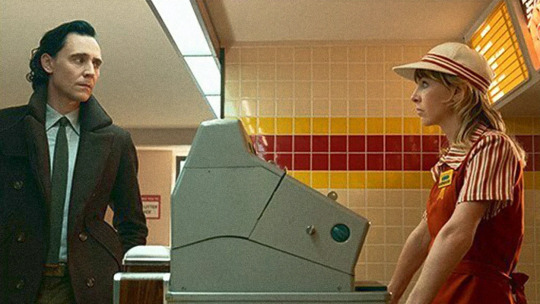
How Marvel officially added McDonalds to the MCU
On the very last day of filming on the first season of the Marvel Disney+ TV series Loki, executive producer Kevin Wright sat on the steps of The Citadel at the End of Time with costar Sophia Di Martino (Sylvie), and they started to chat about what might be next for her character. Not in any official script capacity, just as fans of the story they’d just finished filming.
“This character had been on a decades-long, maybe centuries-long revenge mission, and the classic trope of those stories is that it’s all-consuming and she’s not thinking about what comes next,” says Wright. “Now she has this moment of opportunity, where is she going to go?”
Di Martino thought about it for a moment, and said, “She’d probably be pretty hungry.
There are more than 13,000 McDonald’s across the United States right here in 2023, and untold more across the multiverse. In a new campaign launched this week, the fast-feeder gave Marvel and Loki fans a peek at its own cameo in the series’ upcoming second season, set to launch on October 6.
“As Featured In” is the Golden Arches latest Famous Orders meal campaign and, instead of being tied to a particular artist or character, it celebrates all the instances in TV and movies that McDonald’s has appeared or been mentioned by characters: Friends, The Office, Seinfeld, Space Jam, Coming to America, and many, many more. But at the center of the campaign is Loki, one that hasn’t even happened yet, which is probably appropriate for a show that revolves around the multiverse and many different timelines.
The meal itself—a choice of a 10-piece Chicken McNuggets, Quarter Pounder with Cheese, or Big Mac, with medium fries, a Loki-branded Sweet ‘N’ Sour Sauce, and a medium soda—is, like the Famous Meals before it, nothing all that special, but that has always been the point. The genius of Famous Orders is that it drives customers to McDonald’s core menu items rather than a limited-time stunt. There is, of course, also a merch collaboration, this time with streetwear darling Palace Skateboards. The packaging features QR codes that customers can scan to get fun Loki content and buy pieces from the Palace collaboration.
Long after his conversation with Di Martino on the Citadel set steps, Wright and his team were developing season two, and they were finding it difficult to pick up a new Sylvie storyline. She had just killed He Who Remains in season one, where does she go?
“When we stayed in the view of character, this woman who went on the run as a child, had been running through time, a fugitive of time, living in apocalypses, never being able to relax or slow down, the novelty of walking into a 1980s McDonald’s looked appealing,” say Wright. “You play a Little League game and go to McDonald’s. You go to a kid’s birthday party at McDonald’s. Someone like Sylvie would never have experienced that, and would be really taken by that.”
Marvel Studios has been a brand partnerships factory since Iron Man first ate a Whopper in 2008. Typically these things happen when there is a finished script, and producers go through it with the studio’s brand partnerships team to see where opportunities may be. A car chase, you say? What brand of car should we use? Maybe an Audi?
But this latest collaboration happened in reverse. A 1982 McDonald’s was specifically written into the script, so Wright approached Marvel’s partnerships people to talk to the brand about helping them out with the details. “I was worried that McDonald’s would think we wanted to do something ironic or make fun of them,” says Wright. “But we were selling an earnest story, a love letter to nostalgia through a character’s eyes who will see all of the novelty and joy of it.”
He needn’t have worried. “When I pitched it, our internal team said, ‘Uh, you realize we have a partnership with McDonald’s already, right? The fact we’re going to them wanting to do something makes it even better.”
Around that same time mid-last year, McDonald’s marketing execs were on a tour of sorts, meeting with content creators and creative teams at studios like Disney about the brand’s interest in participating in cultural moments beyond the typical product tie-in. That’s when the call from Marvel about Loki came in.
“We tend to embrace things like this,” says McDonald’s global chief marketing officer Morgan Flatley, “which we feel can be an opportunity for us to learn, especially because we felt that between Marvel and Loki, there was a real willingness to take their rabid fandom and mix it with a fan truth around McDonald’s and bring them together.”
The fan truth Flatley refers to is of McDonald’s as a congenial gathering place, a common experience for so many people. “Sylvie’s storyline perfectly aligned with how we think about our brand in terms of providing comfort and familiarity,” says Flatley. Familiarity is the key to the emotion of nostalgia and shelter that Wright was aiming for in the story.
That same familiarity is indicative of a brand so ubiquitous, it’s become a cultural touchpoint. Hence all the McDonald’s references in TV and movies. There’s a reason McDowell’s works as such a big bit in the classic comedy Coming to America. We all get it.
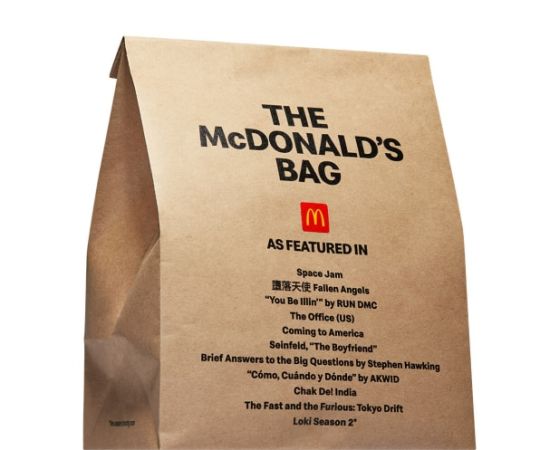

That all sounds great, but many brands get nervous or overprotective when they aren’t in full control of the creative. Not that long ago, McDonald’s was among them. The success of Famous Orders, allowing artists and partners like Cactus Plant Flea Market to play with its brand logos and characters, and the passionate response from fans—along with the sold-out merch and boosted sales—has given Flatley and the brand more confidence than ever in what she calls “sharing the pen.”
“I’ve become a big believer that if we lean into the right kind of creators in the right cultural phenomenon, and loosen some of our control on the brand, magic will happen,” says Flatley. “A few years ago, I don’t know that we would have felt as comfortable handing over key aspects of our brand to be part of a storyline like this, but today we’re really aware of the authenticity of our brand and the role that it can play.”
Wright is very familiar with the pitfalls of ill-conceived brand partnerships, and the impact they can have. “Wayne’s World was making fun of this stuff 30 years ago,” says Wright. “When it’s done poorly, it looks like business not driven by story. I don’t think that was ever a concern for us, mainly because we knew it was being driven by our story, and the more McDonald’s partnered with us, the better we were able to service the story.”
Multiversal marketing? Let’s see McDowell’s try that.
63 notes
·
View notes
Text

Photo: Patch Bell
Outlander and Karen Pirie star Lauren Lyle on her self-belief and taking the leap to pursue her dream
Nominated for two awards at the Scottish Baftas this evening, Lauren Lyle promises it will be a celebration no matter the outcome.
The Glasgow actress has grafted hard to enjoy a remarkable rise over recent years, headlined by her first leading role in Karen Pirie, the acclaimed St Andrews-set crime drama based on Val McDermid’s novels.
Next year is set to be the 30-year-old star’s biggest yet, with several leading roles in film and TV, including a second series of Karen Pirie, so now seems like a good time to pause and look back on her career so far.
“I moved to London at 19 and if I’d told myself then that I’d have my own TV show, had done one of the biggest shows in America (Outlander) and would be working all the time, I don’t think I would have believed it,” she smiled.
“I would have thought I’d needed to have done something terrible to have got here, but I just worked really hard. I’m working on a show called Toxic Town for Netflix, which has Rory Kinnear and Jodie Whittaker in it, and I asked both what their secret is. They said they didn’t know, they just keep working, and they’re testament to doing great work and not trying to be famous.
“Rory told me he always wanted to be known for being good, and I’m the same. I’m trying to pick good things and be in quality stuff, things that excite me and getting to work with good people.
“I came to London to audition for drama schools and came close but didn’t get in. I think I’d only been to London once before as a kid but didn’t remember it. I was so hungry for it, and being around other actors in this world was so thrilling and I knew this was what I wanted to do and the place to do it.”
Taking the plunge
Lauren moved into a shared house with four people she hadn’t previously met. She took on several jobs to pay the bills while trying to engineer a break, joining a theatre company and eager to learn.

Photo: Patch Bell
“It was a risk but I put my head down and grafted hard,” she said. “I think I’ve always had deluded confidence that I can do something. My mum is a school PE teacher and I was a gymnast and runner and I’ve always been competitive to win the race, but that’s not helpful at times because there isn’t a finishing line or right answer here; there’s lots of different ways to do this, so I’ve had to put those feelings aside at times.
“I had a big agent for about a year before I got a job, and then two came within two or three weeks of each other – Outlander and Broke, with Sean Bean – and my life changed. I did my tax return for that year and realised I’d done about six jobs – dog walker, flyering, receptionist, in Zara’s stock room for 18 months. Random stuff that I did for ages.
“It was bleak at times but I loved going to the theatre and seeing this life dangled in front of me. It was quite inspiring.”
Karen Pirie
Lauren’s recurring role as Marsali in Outlander was her break, while BBC thriller Vigil, where she played activist Jade, introduced her to a different audience. When Karen Pirie came along last year, she felt ready.
“I’m so proud to be part of the show. It was so well made, beautifully shot, and with a crew who were hungry to be there. It was my first lead and I had creative control around what she looked like and who she was,” Lauren explained.
“The director, Gareth Bryn, writer Emer Kenny – who also executive produced – and myself were constantly in conversation. We all had such a brilliant time, and it was a story that meant something and said something of young women.
“It was about a young woman trying to solve a crime about another young woman, so Karen knew what it’s like to be afraid to walk home alone at night, and how a young person can be underestimated in the workplace and how difficult it can be to prove themselves.”
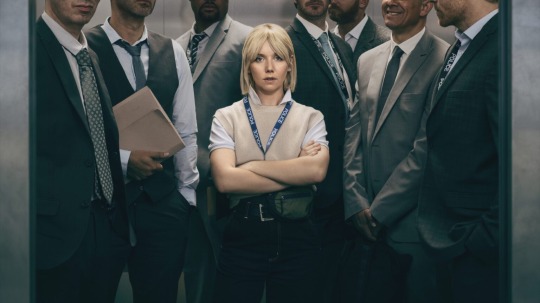
Photo: ITV
Based on Val McDermid’s novel The Distant Echo – about the cold case investigation of a 19-year-old woman’s death which is reopened and given to DS Karen Pirie after a podcast cast doubt on the original investigation – it was a Sunday night hit for ITV last year.
“Val has been complimentary and incredibly supportive of me,” Lauren continued. “She had to sign off on me playing the character. I was worried if she would be happy with the Methil accent. She visited the set and I prepared myself, but she said I was very good.
“She messaged me on Twitter when the awards nominations were announced and congratulated me and said we would need to go for a drink. I’d love to have a drink with her – I’m sure she would have some great stories!”
Scottish Baftas
The drink will be flowing this evening at the Scottish Baftas in Glasgow where, in addition to Lauren’s two nominations, Karen Pirie is also in the fiction director and scripted television categories.
“The show came out too late for the 2022 awards, but it’s nice that we’ve since announced a second series. We have a big Karen Pirie table. My parents are coming – my dad has a new velvet jacket to go with his tartan troos – as is my boyfriend, who is South-African-Australian, but we’ve recently discovered he has lots of Scottish heritage, so he might wear a kilt, and my agent will be there, too.
“Everyone is dead excited and the whole team is there to celebrate.”
Lauren’s nomination in the Audience Award category sees her vying with Brian Cox, Lewis Capaldi, Tony Curran, Hamza Yassin and Meryl Williams.
“To be in a category with Brian, Lewis and the legend that is Meryl from The Traitors, I feel that’s the only time in my life this will happen. I’m tempted to say to Brian that if he ever needs me to play his granddaughter or daughter, I’m here. Someone should cast us all as a family.”
New projects
With a second series of Karen Pirie expected to start shooting early next year and a rumoured return for the final series of Outlander – “we may be talking, who knows” is all Lauren will say – 2024 will be another busy one for her.
She will follow up her first starring role in a movie, Mercy Falls, which was released earlier this month, with another two movies to be released next year – thriller Something In The Water and The Outrun, with Saoirse Ronan and Jack Lowden.
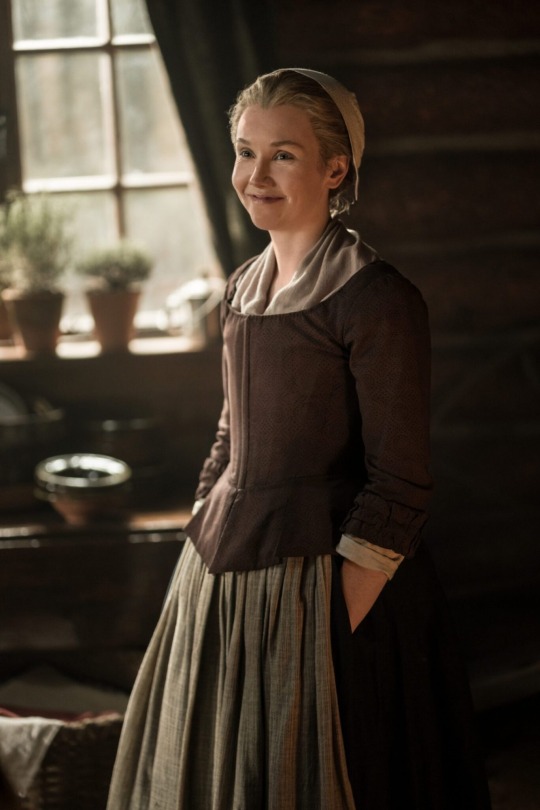
Photo: Robert Wilson / Starz
“We filmed Something In The Water in the Dominican Republic. It’s like Bridesmaids but a thriller. The Outrun was filmed on Orkney. Saoirse and Jack saw me in Vigil and asked if I’d be part of this film, which is the first from their production company.
“I had to get the Orkney accent just right. At the first read-through, Amy Liptrot, the writer of the book it’s based on, said it needed to be a bit less Shetland and a bit more Orkney, so I went away and made sure it was right.
“Everyone was so welcoming on Orkney. The beaches were ridiculous. I was stung by a weever fish, which apparently is an unusual thing to happen. My foot was on fire for a day.
“I’ve also been making Toxic Town, a new series for Netflix which is about the Corby poisonings, one of the UK’s biggest environmental scandals, which no-one really knows about. It’s about mothers in a David vs Goliath battle for justice, and I’m wearing lots of ‘90s and ‘00s power suits.
“As well as Jodie and Rory, it has people like Aimee Lou Wood from Sex Education, Joe Dempsie from Skins, Claudia Jessie from Bridgerton, Michael Socha from This Is England, and Robert Carlyle, who is the nicest man in the world.”
Shooting in Scotland
Despite living in London, Lauren finds many of her jobs are being shot in Scotland, which she’s happy to see.
“Nowhere looks like Scotland and a lot of productions are coming here for that reason,” she added. “It’s really cool to see it happening and it’s a testament to the quality of workers you get here.
“Plus, it gives me a free trip home to see my family.”
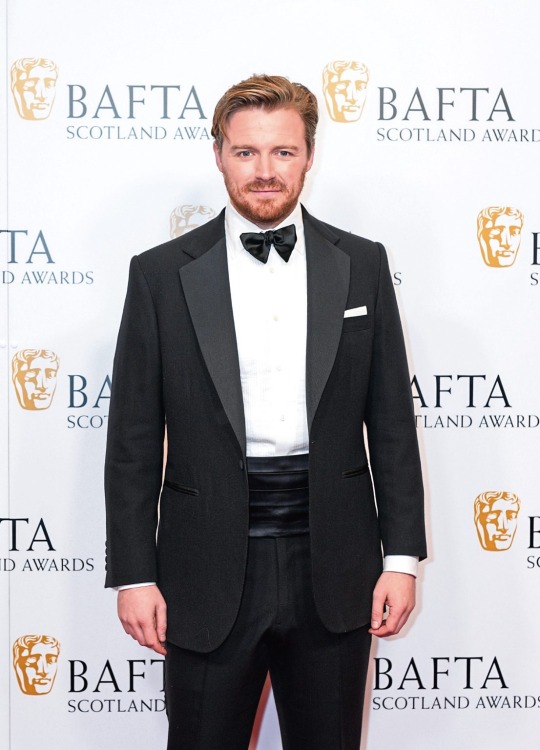
Photo: Stuart Wallace / Shutterstock
At last year’s Scottish Baftas, Dunkirk and The Gold actor Jack Lowden spoke glowingly about Lauren Lyle.
The pair have since become friends and colleagues, and Lauren is keen to support new talent coming through in Scotland just as Jack did with her.
Speaking about this evening’s Scottish Baftas, Lauren said: “Me and Jack were talking about how great it is to get a lot of Scots in a room to congratulate each other, all these people doing well from this proud place, on international stages representing our country, heritage and culture, which we’re so proud of.
“It’s a great opportunity to shake everyone’s hands and say ‘aren’t we an amazing team?’
“I want to know who the other young people are. We’d like to be able to speak to the younger Scottish actors and welcome them in. Jack did that with me – talking about me, being supportive and asking me to be part of his film. I don’t know if we’d met at the point he spoke about me at the Scottish Baftas. I was very flattered.
“He and Saoirse have been really cool and supportive, and I hope to do the same at some point. With season two of Karen Pirie coming, I message its writer, Emer Kenny, and tell her to keep an eye out for this guy and this girl.”
Remember… she will follow up her first starring role in a movie, Mercy Falls, which was released earlier this month, with another two movies to be released next year – thriller Something In The Water and The Outrun, with Saoirse Ronan and Jack Lowden. — The Sunday Post
39 notes
·
View notes
Text
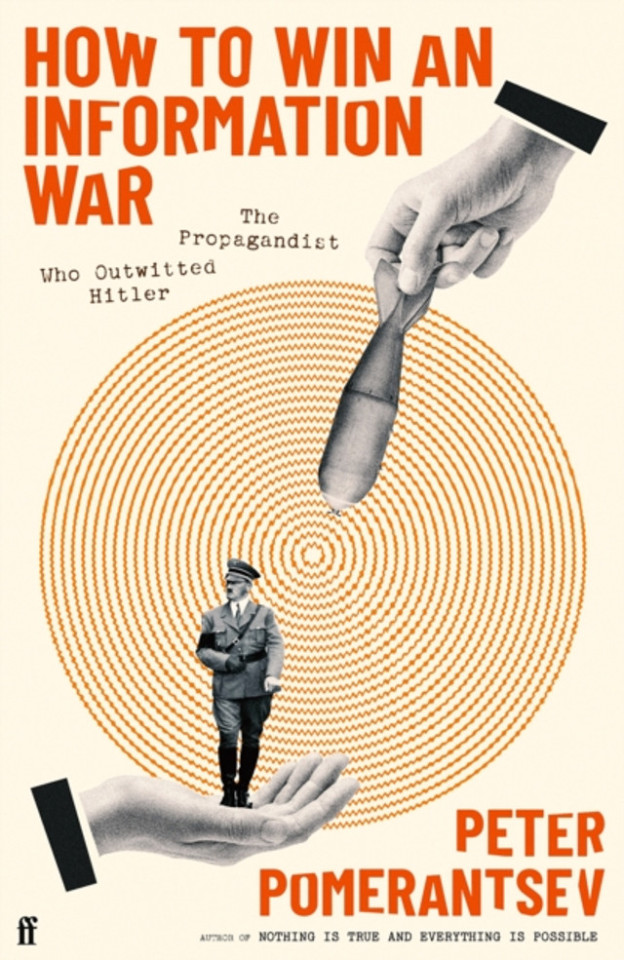
In 1941 a secret British radio station called on Germans to rise up against Hitler. Run by German exiles, it was explicitly left wing. The station’s target audience was “the Good German”. Its broadcasts were serious and idealistic: a ray of light amid totalitarian darkness. They were also a complete flop. With Nazi propaganda rampant, and Hitler’s armies seemingly invincible and on the march across Europe, few bothered to listen in.
It was at this point that Britain’s wartime intelligence services tried a more radical approach. That summer, a talented journalist called Sefton Delmer was given the job of beating the Nazis at their own information game. Delmer spent his childhood in Berlin and spoke fluent German. In the early 1930s he chronicled Hitler’s rise to power – flying in the Führer’s plane and attending his mass rallies – as a correspondent for the Daily Express.
Working from an English country house, Delmer launched an experimental radio station. He called it Gustaf Siegfried Eins, or GS1. Instead of invoking lofty precepts, or Marxism, Delmer targeted what he called the “inner pig-dog”. The answer to Goebbels, Delmer concluded, was more Goebbels. His radio show became a grotesque cabaret aimed at the worst and most Schwein-like aspects of human nature.
As Peter Pomerantsev writes in his compelling new study How to Win an Information War, Delmer was a “nearly forgotten genius of propaganda”. GS1 backed Hitler and was staunchly anti-Bolshevik. Its mysterious leader, dubbed der Chef, ridiculed Churchill using foul Berlin slang. At the same time the station lambasted the Nazi elite as a group of decadent crooks. They stole and whored, it said, as British planes bombed and decent Germans suffered.
Delmer’s goal was to undermine nazism from within, by turning ordinary citizens against their aloof party bosses. A cast of Jewish refugees and former cabaret artists played the role of Nazis. Recordings took place in a billiards room, located inside the Woburn Abbey estate in Bedfordshire, a centre of wartime operations. Some of the content was real. Other elements were made up, including titillating accounts of SS orgies at a Bavarian monastery.
The station was a sensation. Large numbers of Germans tuned in. The US embassy in Berlin – America had yet to enter the war – thought it to be the work of German nationalists or disgruntled army officers. The Nazis fretted about its influence. One unimpressed person was Stafford Cripps, the future chancellor of the exchequer, who complained to Anthony Eden, the then minister for foreign affairs, about the station’s use of “filthy pornography”.
By 1943, Delmer’s counter-propaganda operation had grown. He and his now expanded team ran a live news bulletin aimed at German soldiers, the Soldatensender Calais, as well as a series of clandestine radio programmes in a variety of languages. Delmer’s artist wife Isabel joined in. She drew explicit pictures showing a blonde woman having sex with a dark-skinned foreigner. Partisans sent the pamphlets to homesick German troops stationed in Crete.
Others who made a contribution to Delmer’s productions included Ian Fleming, the creator of James Bond, and the 26-year-old future novelist Muriel Spark. Fleming worked for naval intelligence. He brought titbits of information that made the show feel genuine, including the latest results from U-boat football leagues. Many Germans guessed the station was British. But they listened anyway, feeling it represented “them”.
Pomerantsev is an expert on propaganda and the author of two previous books on the subject, Nothing Is True and Everything Is Possible and This Is Not Propaganda. The son of political dissidents in Kyiv, he was born in Ukraine and grew up in London. During the 00s he lived in Moscow and worked there as a TV producer. Since Vladimir Putin’s 2022 invasion he has been part of a project that documents Russian war crimes in Ukraine.
Like Delmer, Pomeranstev has personal experience of two rival cultures: one authoritarian, the other liberal and democratic. He draws parallels between the fascist 1930s and our own populist age. The same “underlying mindset” can be seen in dictators such as Putin and Xi Jinping, and wannabe strongmen and bullies such as Donald Trump. “Propagandists across the world and across the ages play on the same emotional notes like well-worn scales,” he observes.
In Pomerantsev’s view, propaganda works not because it convinces, or even confuses. Its real power lies in its ability to convey a sense of belonging, he argues. Those left behind feel themselves emboldened and part of a special community. It is a world of grievance, victimhood and enemies, where facts are meaningless. What matters are feelings and the illusion propaganda lends of “individual agency”. Its practitioners bend reality. And – as with Putin’s fictions about Ukraine – make murder possible.
The book offers a few ideas as to how we might fight back. When horrors were uncovered in Bucha, the town near Kyiv where Russian soldiers executed civilians, Ukraine’s president, Volodymyr Zelenskiy, appealed to the Russian people. This didn’t cut through. Most preferred to believe the version shown on state TV: that Moscow was waging a defensive fight against “neo-Nazis”. It was a comforting lie that absolved Russians of personal responsibility.
Ukrainian activists hit a similar wall when they cold-called Russians and told them about the destruction caused by Kremlin bombing. Many called relatives in St Petersburg and other Russian cities to explain they were under attack. Typically, their family members did not believe them. “They really brainwashed you over there,” one said.
The activists had more success when they mentioned taxes or travel restrictions – issues that spoke to the self-interested “pig-dog”. Pomerantsev suggests that Delmer’s approach worked because he allowed people to care about the truth again, nudging them towards independent thought, while avoiding the pitfall of obvious disloyalty. He brought wit and creativity to his anti-propaganda efforts as well, turning his radio shows into bravura transmissions.
Pomerantsev makes an intriguing comparison between der Chef and Yevgeny Prigozhin, the Russian oligarch who in summer 2023 staged a short-lived rebellion against Putin. Two months later, Prigozhin died in a plane crash. The oligarch was a charismatic figure who roasted Russia’s generals for their incompetent handling of the war. He used earthy prison slang. It was this ability to communicate in plain language that made him popular – and a rival.
The book muses on whether Delmer was ultimately good or bad. Are tricks and subterfuge justified in pursuit of noble goals? It concludes that the journalist’s greatest insight was his understanding of his own ordinariness, and how this might be exploited by unscrupulous governments and rabble-rousing individuals. “He was vulnerable to propaganda for the same reasons we all are – through the need to fit in and conform,” Pomerantsev notes.
Daily inspiration. Discover more photos at Just for Books…?
16 notes
·
View notes
Text
[“Mainstream feminism too often puts ‘police violence’ and ‘male violence against women’ into different conceptual categories – if, indeed, it considers police violence to be a topic of feminist concern at all. This is especially the case for the violence that is ‘normalised’ as part of policing: arrests, most obviously, but also violations such as intimate searches, and harassment such as stop-and-frisk. The result is that police violence gets left out of mainstream feminist anti-violence work. However, when we think of police violence not only as state violence but also (often) as male violence against women, the criminalisation of prostitution comes into focus in a new way: as a key driver of male violence against women.
The infrastructure of criminalisation saturates our political consciousness. It is the bobby on the beat, the jail on the Monopoly board, the crime-drama TV show (with its inevitable murdered prostitute), the car-chase footage on the news. In this saturation, such images are rendered mundane, sidelining questions of the legitimacy or purpose of these modes of control. As Angela Davis writes, the prison ‘is one of the most important features of our image environment’, yet it
functions ideologically as an abstract site into which undesirables are deposited, relieving us of the responsibility of thinking about the real issues afflicting those communities from which prisoners are drawn in such disproportionate numbers. This is the ideological work that the prison performs – it relieves us of the responsibility of seriously engaging with the problems of our society, especially those produced by racism and, increasingly, global capitalism.
Theorist Beth Richie uses the term prison nation to mean a ‘broad notion of using the arm of the law to control people, especially disadvantaged people and people from disadvantaged communities’. Her term encompasses not only the physical infrastructure of prisons and jails, but also ‘surveillance, policing, detention, probation, harsh restrictions on child guardianship … and other strategies of isolation and disposal’.
Perhaps the key trick of the prison nation is ‘now you see it, now you don’t’. Prison vanishes people; criminalisation renders those same people hyper-visible. The deeply racialised, anti-Black figure of the Pimp looms large as the perpetrator of ‘slavery’ – while the prison system itself, one of the key material legacies of chattel slavery in the Americas, is filled with ever more Black inmates.
Through the intensifying militarisation of police departments, there is a direct link between the foreign wars at the frontiers of the contemporary American empire and the hyper-carceral state at home. As the New Yorker reports, since the 1990s, ‘local governments have received approximately thirty-four billion dollars in grants from the Department of Homeland Security to buy their own military equipment … That brings the total [spent by American police departments on military equipment] to thirty-nine billion dollars – more than the entire defense budget of Germany.’ The same trend is visible even in the histories of policing; early-twentieth-century American policing drew on the US Army’s experience imposing brutal colonial rule in the Philippines, just as UK policing explicitly drew on tactics developed by the British Army in subduing colonised populations.
Communities feel the police are an occupying army; the police feel themselves to be an occupying army, and the police respond to the people they encounter with the hostility that engenders. Some of the most powerful photography emerging from the ongoing fight for Black lives in the US speaks to the visual dimension of this: an iconic photograph taken in Baton Rouge, Louisiana, shows Ieshia Evans, a young Black woman in a summer dress, calmly facing down two oncoming police officers in full body-armour. Meanwhile, the overlapping military and prison industrial complexes drain hundreds of billions of dollars from the American public purse, outfitting the police who rushed Ieshia in futuristic ‘protective’ armour – alongside cuts to Social Security, healthcare, and education, and catastrophic divestment from Black communities.”]
molly smith, juno mac, from revolting prostitutes: the fight for sex workers’ rights, 2018
41 notes
·
View notes
Text
List of Films Turning 10 Years Old in 2024
The Amazing Spider-Man 2
American Sniper
Annie (the remake starring Jamie Foxx)
As Above, So Below
The Babadook (we stan a gay icon)
Batman: Assault on Arkham (a direct continuation of the Batman: Arkham games)
Big Eyes
Big Hero 6
Birdman (won the Best Picture Oscar for this year)
The Book of Life
The Boxtrolls
Boyhood (filmed over the course of 12 years)
Captain America: The Winter Soldier
Chef
Dawn of the Planet of the Apes
Dead Snow 2: Red vs. Dead
Dear White People (the basis for the TV series on Netflix, and made by the same guy)
Dracula Untold (this was Universal’s second attempt at launching the Dark Universe)
The Drop (a crime drama starring Tom Hardy)
Edge of Tomorrow/Live Die Repeat
The Equalizer
Exodus: Gods and Kings (a biblical epic directed by Ridley Scott)
The Expendables 3
The Fault in Our Stars
Foxcatcher
Fury (the war movie with Brad Pitt and Shia LaBeouf)
Get on Up (the James Brown biopic starring Chadwick Boseman)
Godzilla (the 1st film in the MonsterVerse)
Gone Girl
The Grand Budapest Hotel
Guardians of the Galaxy Vol. 1
The Guest
Hercules (the one starring The Rock)
The Hobbit: The Battle of the Five Armies (did you guys know the working title for this movie was “The Hobbit: There and Back Again”?)
How to Train Your Dragon 2
The Hunger Games: Mockingjay Part 1
If I Stay
The Imitation Game (the movie where Benedict Cumberbatch plays Alan Turing)
Inherent Vice
Interstellar
The Interview (the movie that almost caused World War 3)
Into the Woods
Jack Ryan: Shadow Recruit
Jodorowsky's Dune (a documentary about the Dune movie that we never got)
Joe (one of Nic Cage's best movies)
John Wick (the 1st one)
Kill the Messenger
Left Behind (one of Nic Cage's worst movies)
The Lego Movie
Life After Beth
Lucy ((the “humans only use 10% of their brain” movie. Which has since been proven false. Source: https://www.scientificamerican.com/article/do-people-only-use-10-percent-of-their-brains/ )
Maleficent
The Maze Runner
A Million Ways to Die in the Weset
Mr. Peabody and Sherman
Muppets Most Wanted
Need for Speed (Aaron Paul's first project after "Breaking Bad" ended)
Neighbors
Night of the Museum: Secret of the Tomb (the third one. Also one of Robin Williams’ last movies)
Nightcrawler
Noah (a biblical epic directed by Darren Aronofsky)
Non-Stop
The Nut Job
Obvious Child
Oculus (one of the 1st projects from Mike Flanagan)
Ouija
Paddington
Penguins of Madagascar
The Purge: Anarchy
The Raid 2
RoboCop (the reboot that was actually decent)
Selma
Sharknado 2
Sin City: A Dame to Kill For
Son of Batman
St. Vincent
The Taking of Deborah Logan
Teenage Mutant Ninja Turtles (the one produced by Michael Bay. It’s also the one where the Turtles look like aliens)
The Theory of Everything (the movie where Eddie Redmayne plays Stephen Hawking)
Third Person
300: Rise of an Empire
Transformers: Age of Extinction
Tusk
22 Jump Street
Veronica Mars (the film continuation of the TV show)
A Walk Among the Tombstones
What If? (a rom-com starring Daniel Radcliffe)
What We Do in the Shadows (the film that was the basis for the TV show)
When Marnie Was There
Whiplash
X-Men: Days of Future Past
#the amazing spider man#annie musical#clint eastwood#the babadook#batman#batman arkham series#tim burton#big hero 6#birdman#the book of life#captain america#captain america the winter soldier#planet of the apes#dead snow#dracula#live die repeat#tom cruise#the equalizer#denzel washington#ridley scott#the expendables#the fault in our stars#john green#james brown#chadwick boseman#godzilla#monsterverse#gone girl#wes anderson#guardians of the galaxy
19 notes
·
View notes
Text
Alissa Wilkinson at Vox:
The Hollywood writers strike marked its one-month anniversary on Friday, with no signs of slowing down. While other guilds in the industry are still on the job — except when they’re blocked by picket lines — the writers may soon get company on those picket lines.
Two other major entertainment guilds, the Directors Guild of America (DGA) and Screen Actors Guild (SAG-AFTRA), also entered the summer with looming contract expiration dates. Both groups’ agreements with AMPTP, the trade association that represents the industry’s film and TV production companies, end on June 30. A lot could happen between now and then, but the situation is looking dicey.
All of that means that come July 1, the studios may be facing a double or even triple strike, in effect shutting Hollywood down completely.
The DGA rarely strikes — the last time was in 1987 — and its leadership has not called for a strike authorization vote. But its relations with the AMPTP have been trickier than usual. Negotiations began on May 10, with demands that in part mirror the WGA’s concerns. The main sticking point is wage and residual increases that keep in step with rising costs of living. In particular, lower residuals for shows on streaming services, where the lion’s share of entertainment now lives, have wreaked havoc for many people in the industry, drastically reducing compensation and making it increasingly difficult to just pay the bills.
In the past, the DGA has sometimes managed to make an agreement with AMPTP ahead of the start of bargaining, effectively setting a pattern for the WGA and SAG-AFTRA to follow in their own demands. Last November, the DGA sent a “pre-negotiation” offer to the AMPTP, seeking resolution ahead of bargaining. The AMPTP reportedly rejected the DGA’s proposal, meaning both parties came to the bargaining table without an arrangement.
The situation seemed to intensify due to an unforced error. On May 23, Warner Bros. Discovery launched Max, its newly rebranded streaming platform, which had previously been named HBO Max. Eagle-eyed observers noticed that in listed credits, the platform lumped writers, directors, producers, and so on into one category labeled “creators.” Aside from the queasy implications that the greatest works of cinema and television were just “content,” the choice on the company’s part ran afoul of hard-fought contract regulations regarding credits for artists.
It was a weird choice, and one that set blood boiling in Hollywood. The presidents of the WGA and the DGA issued a rare joint statement, with DGA president Lesli Linka Glatter noting that “The devaluation of the individual contributions of artists is a disturbing trend and the DGA will not stand for it. We intend on taking the strongest possible actions, in solidarity with the WGA, to ensure every artist receives the individual credit they deserve.”
By the end of the day, Warner Bros. Discovery announced that it would modify how credits were listed on the platform in compliance with its preexisting contract agreement with the unions. Yet the strong language indicated that the DGA was ready to play hardball.
Meanwhile, members of SAG-AFTRA have been vocally supportive of the WGA. This is no shock, since on top of the same issue of residuals and wages, the union — which includes, in addition to film and TV actors, people who work in radio, singers, voice actors, influencers, models, and other media professionals — is concerned about the existential threat posed by AI and other technologies. Even before the WGA’s strike began, SAG-AFTRA issued statements regarding how the use of AI could eliminate or greatly reduce work for its members.
Members of SAG-AFTRA have shown up on picket lines to support the writers, and the star power posed by some of its most prominent members helps bring attention to the WGA’s strike. It’s also an effort to remind the studios that when their own negotiations begin, they’re ready for a fight. Underlining that implicit statement, the leadership of SAG-AFTRA unanimously agreed to ask its membership for a strike authorization vote, which concludes this coming Monday, June 5. That’s a move designed to signal solidarity to the AMPTP ahead of negotiations.
[...]
Here’s what’s most significant about all of this: All three unions have never gone on strike at the same time, in the history of Hollywood. The fact that this scenario is possible, even likely, emphasizes how extraordinary this moment is in the entertainment business.
Hollywood could be on the verge of a triple strike that could effectively shut down everything completely. The WGA strike is ongoing, but the SAG-AFTRA and/or the Directors Guild could also launch their own strikes.
#WGA Strike#WGA#2023 WGA Strike#SAG AFTRA#Directors Guild of America#Strikes#Labor#2023 SAG AFTRA Strike#Max#HBO Max#Streaming#Television
67 notes
·
View notes
Text
youtube
The singer Lonnie Donegan was born on April 29th 1931 in Bridgeton Glasgow.
Donegan was born Anthony James Donegan, the son of a Scottish father and Irish mother. His father was a professional violinist who had played with the Scottish National Orchestra.
He moved with his mother to London at an early age, after his parents divorced. Inspired by blues music and New Orleans jazz bands he heard on the radio, he resolved to learn the guitar, and bought his first at the age of fourteen. He took his first name after a New Orleans blues singer he admired called Lonnie Johnson.
The first band he ever played in was the trad jazz band led by Chris Barber, who approached him on a train asking him if he wanted to audition for his group. Barber had heard that Donegan was a good banjo player; in fact, Donegan had never played the banjo at this point, but he bought one and managed to bluff his way through the audition. His stint in this group was interrupted, however, when he was called up for National Service in 1949.
In 1952, he formed his first own group, the Tony Donegan Jazzband, which found some work around London. On one occasion they opened for the blues musician Lonnie Johnson at the Royal Festival Hall. Donegan was a big fan of Johnson, and took his first name as a tribute to him. The story goes that the host at the concert got the musicians’ names confused, calling them “Tony Johnson” and “Lonnie Donegan”, and Donegan was happy to keep the name.
Donegan recorded a reworking of an American folk tune, Rock Island Line. Decca released the song in 1956, billed by the Lonnie Donegan Skiffle Group. The record, with its talking sequences, homage to Americana, and fast train shuffle climax, became a major hit in Britain and America. Because he was paid a flat fee for the session, Donegan didn’t receive any royalty payments for his most popular and influential song until the label struck a new deal for him 40 years later. However, Rock Island Line made him a star in his own right and would remain his signature song throughout his career.
From 1956 through 1962, he enjoyed a string of 34 British hits including Puttin’ on the Style and Cumberland Gap, which hit number one in 1957, Don’t You Rock Me Daddy-O, which reached number four in the same year, and the raucous sing-along My Old Man’s a Dustman which climbed to the top of the charts in 1960. It’s not hard to see why Lonnie is regarded as the first real pop star, his fans included the likes of Lennon and McCartney, who’s first group, The Quarrymen were a skiffle group. he Shadows, the Searchers, the Hollies, Herman’s Hermits, Gerry & the Pacemakers, and Cliff Richard all began their musical lives doing skiffle.
As the swinging sixties rolled on Donegans hits dried up but he was always in demand for gigs at home and across the world, he also dabbled in a wee bit acting and his own song publishing business, his most popular song he bought the rights for being Nights in white Satin. In the 70’s he popped upon the occasional TV shows during breaks from touring, in 1972 Tom Jones covered one of Lonnie’s songs and it went top 5 on both sides of the Atlantic. As a performer he continued to record and lease unsuccessful sides to Pye, Decca, Black Lion, and RCA.
A 1976 heart attack forced Donegan into an uneasy semi-retirement in California. Two years later, Chrysalis Records organized an all-star recreation of his early hits Puttin’ on the Style. Produced by former British teen idol Adam Faith and boasting duets with Ringo Starr, Elton John, and Rory Gallagher, it was his last major-selling album. Follow-ups with respected session ace Albert Lee and Cajun-fiddler Doug Kershaw seemed to point him towards country music, but a series of heart attacks in 1979 ended his full-time career.
In later years Donegan made a series of guest appearances with old friend Chris Barber including a featured spot on Van Morrison’s Skiffle Sessions: Live in Belfast 1998. Just before his death, he returned to touring full time, exhibiting much of his classic verve and humour before standing-room-only crowds. Donegan died on November 3rd, 2002, in Peterborough.
13 notes
·
View notes
Text
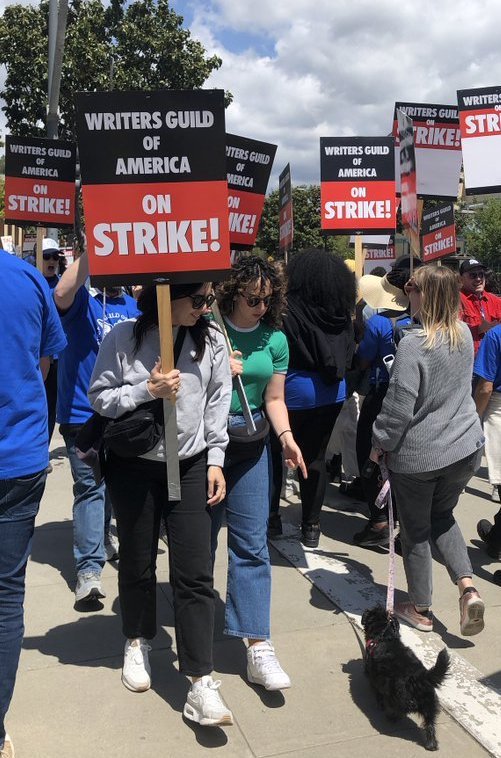
for the first time since 2007, the Writers Guild of America is on strike.
Every year the WGA negotiates with the employers (the Alliance of Motion Picture and Television Producers) a basic set of standards. This year they couldn't agree, so the writers are stopping work and walking the picket line.
THE ISSUES
Last time this happened we got the Reality TV boom (including The Apprentice which made Trump a national celebrity. See what happens without writers?)
the biggest sticking points are how streaming shows cut corners to pay writers less (e.g. smaller writing staff, shorter contract time, not paying residuals based on audience numbers) and rules around AI (the same issue artists are having-- their work is being plundered in "training sets" for AI toward an end goal of replacing human writers entirely.)

67 notes
·
View notes
Text
*Long rant warning* I know it’s been repeated to death this season, but I am so pissed at production this season. This was truly a top tier cast imo (based on entertainment/messiness), and I can attribute all of my frustrations to production.
Ive hated how they edited the show this year (I’ve been pretty vocal about being salty about the Americory edit obviously, but they also barely showed Izzy and painted Cameron as a hero; I really don’t think non-live feeders have a great understanding of the characters on the show)
The Zombie twist is quite literally the worst twist of all time. The invisible HOH was a flop and they still let Jag compete AND win the following HOH. Honestly besides Path to Power (which in hindsight, I kind of wish didn’t happen, but I was pretty stoked with it at the time), every game twist has been awful
The comps have been incredibly similar and have favored male competitors. (I mean COME ON, they used the SAME veto comp for both double evictions)
And overall just very questionable decisions. Why wasn’t Jared removed after saying the r word? Why were they protecting Cameron SO MUCH on the live feeds? It got to a point where if a contestant mentioned Cameron’s name, they would automatically switch the feeds! Like that doesn’t make him look better — I’m just even more suspicious of him! Why would they cut America’s “I love you” in her goodbye message (especially since she said it *before* they had said it to each other — if Cory had heard that for the first time on live TV, that would have been such good TV!)? I feel like there were just a lot of decisions that kind gave a slap in the face to super fans/live feeders. They’re trying to hide things that CLEARLY we are able to figure out.
For the past couple of seasons, I’ve been pretty firm in thinking that they come up with things ahead of time to avoiding rigging the competition and at the end of the day, they just care about making good television and don’t have “favorites.” It’s very well that I’m biased this year because my favorites are America and Cory, but my god, I feel like this season just had so much blatant favoritism from the start, specifically towards Cameron and Matt (I think Jared was in there to begin with, but I do think they turned when they started to see the writing on the wall)
Idk rant over. I’ve really enjoyed watching this season (despite the rather bleak ending that is possibly coming), but I don’t think I could ever recommend it to people because I don’t think the episodes/show does it justice and I think that the producer decisions post-jury have ruined the endgame.
24 notes
·
View notes
Text
Gaining 'Control'
With the announcement that Jenna Coleman will be co-starring in a new film called Control, it's great that we Jenna fans have more future work by her to enjoy, even if it'll likely be 2025 before the film is released. A few thoughts:
Sadly, it's not an adaptation of the video game. That would rock, especially with Jenna in the lead.
It doesn't appear Jenna has a lead role - though they haven't announced anything about her character so I may be dead wrong on that.
With James McAvoy and Julianne Moore leading (even if Moore appears to be voice-only, like Scarlet Johansson was in Her), and some other big names attached, this does not appear to be the same type of small indy film like Jenna's last two. I've pretty much despaired of seeing Klokkenluider and Jackdaw in my corner of Canada (and I don't stream), but this one looks like the type of film that could hit cinemas. It may stream instead as a lot of films do, but it might be easier to find at any rate.
Not counting her Captain America cameo and the cinema screening of Doctor Who and All My Sons, this will only be Jenna's 4th appearance in a proper theatrical film after Me Before You, Klokkenluider and Jackdaw.
The fact production has begun, assuming Jenna is working right away and not joining later, would indicate that whatever she's done for Sandman Season 2 is likely complete.
So we now have three things to look forward to from Jennaland: The Jetty TV series (coming later this year; I hope we get a trailer soon - her last BBC show, The Serpent - put out a trailer months in advance); Sandman Season 2 (not officially confirmed but I thought I heard Jenna had mentioned working on it); and now Control.
With yet another project that is NOT The War Rooms, the planned TV series announced more than three years ago, it's pretty much confirmed now that despite what IMDb might want you to believe (according to it, the show airs this year), that project is dead. Or, if not dead, the odds of Jenna still being involved (beyond maybe a producing capacity) have likely dropped to nil as she's moved on to other stuff. I still wouldn't write off a future Victoria movie or season (Jenna has said she could play the role for decades), but I'd probably have better luck emailing Jenna and asking her for stock market tips.
I just noticed Sarah Bolger is in Control, too. I know she's done lots of other stuff, but I remember her as Princess Aurora (a.k.a. Sleeping Beauty) in the Canadian-filmed Once Upon a Time TV series a while back.
7 notes
·
View notes
Text
THIS DAY IN GAY HISTORY
based on: The White Crane Institute's 'Gay Wisdom', Gay Birthdays, Gay For Today, Famous GLBT, glbt-Gay Encylopedia, Today in Gay History, Wikipedia, and more … April 28



1901 – Weaver W. Adams (d.1963) was an American chess master, author, and opening theoretician. His greatest competitive achievement was winning the U.S. Open Championship in 1948. He played in the U.S. Championship five times.
Adams is most famous for his controversial claim that the first move 1.e4 confers a winning advantage upon White. He continually advocated this theory in books and magazine articles from 1939 until shortly before his death. Adams' claim has generally been scorned by the chess world. However, International Master Hans Berliner in a 1999 book professed admiration for Adams, and similarly claimed that White may claim a winning advantage, albeit with 1.d4, not 1.e4.
Adams did not succeed in showing the validity of his theory in his own tournament and match play. His results suffered because he published his analysis of White's supposed winning lines, thus forfeiting the element of surprise and enabling his opponents to prepare responses to his pet lines. Future World Champion Bobby Fischer used the Adams Attack, the line Adams advocated against the Najdorf Variation of the Sicilian Defense (6.h3), with success.
Adams' parents were Frank H. Adams and Ethel Weaver Adams. He wrote that he was not directly related to Presidents John Adams and John Quincy Adams, but that the Adamses "in and about Massachusetts are mostly of the same family, deriving from a Henry Adams who landed in Braintree in 1644". Both Weaver and Warren were his ancestral names. His mother's side has been traced back to the founding fathers of America. His father's side has not as yet been established.
Grandmaster Arnold Denker related of Weaver that he was "a master who inherited a chicken farm and who was – so to speak – a White man clear through. He wrote a book, White to Play and Win, lived in a White house on White Street, chewed antacid pills that left the inside of his mouth perpetually White, and raised only white chickens that laid white eggs. Predictably, Adams' business was soon no more than a shell." Harry Golombek wrote in 1977 that Adams, whom he described as "author of White to Play and Win and a sodium bicarbonate addict", was on Golombek's "reserves" list for "the ten most interesting personages" from the past 100 years.
Adams was homosexual, as discussed in his autobiographical article reprinted in Chess Pride.


1920 – John Strauss (d.2011) was an American television and film composer and music editor. Strauss co-wrote the theme song for the NBC television series, Car 54, Where Are You?, with Nat Hiken. He also won a Grammy Award for his work as the producer of the soundtrack for the 1984 film, Amadeus. He was also frequently collaborated with director Woody Allen in his films, including Take the Money and Run in 1969 and Everything You Always Wanted to Know About Sex* (*But Were Afraid to Ask) in 1972.
Strauss was born in New York City. He served in the United States Army in both North Africa and France during World War II. He studied at Yale University with Paul Hindemith following the end of the war.
In addition to co-writing the theme song for the TV sitcom Car 54, Where Are You?, Strauss won an Emmy Award in sound editing for his work on the 1978 television movie, The Amazing Howard Hughes. He also wrote the theme song for The Phil Silvers Show. Strauss appeared briefly as an orchestra conductor in the film Amadeus.
Strauss married actress Charlotte Rae on November 4, 1951, but the marriage ended in divorce when he came out as bisexual in 1976. The couple had two sons. Strauss subsequently became life partners with artist Lionel Friedman.
"They were strong advocates for gay rights, and were arrested during a protest at the Los Angeles office of then-Gov. Pete Wilson," their son Larry said. "They also took part in national marches for gay and lesbian rights, and participated in the making of the AIDS memorial quilt."
Friedman died in 2003. A longtime resident of Los Angeles, Strauss died in that city on February 14, 2011, of Parkinson's disease, at the age of 90.

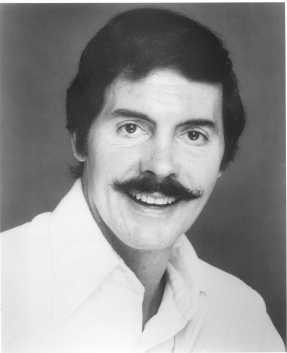
1929 – The Gay activist and writer John Paul Hudson was born on this date (d.2002). With all the humility his detractors claimed he lacks, John Paul Hudson called himself "a militant Gay journalist of the earliest days of Gay Liberation movement."
Hudson was a pioneer of the Gay press, a contributor to a half dozen of the earliest Gay periodicals beginning with Gay in 1969 and The Advocate in 1970, and including David, Gaysweek, NewsWest, Flash and Vector.
Hudson was the organiser of New York City's first gay pride march in 1970 in the wake of the Stonewall riots. In the years following Stonewall, he was a tireless organizer, his growing radicalism more and more reflected in his writing as he himself became increasingly disillusioned with the "organized Gay community" he'd helped to bring about. Like many radicals he was pure of heart and intolerant of hypocrisy. Unlike most radicals, he was not self- righteous. Like all radicals he was unwilling to allow history the necessary time to catch up with itself, insisting that all social changes must be effected NOW.

More than three decades ago, Hudson (as John Francis Hunter) gave us those eccentric and literate guides, The Gay Insider (1971) and The Gay Insider USA: A Hunter's Guide to New York and a Thesaurus of Phallic Lore (1972) and Superstar Murder?: What Happened To Good Queen Bess Her Last Night At The Cosmopolitan Baths?(1976). Without them there could have been no States of Desire, no Gayellow Pages. John Paul Hudson was, in short, an innovator, with a spirit as impatient as his flesh is attractive.
Shortly before his passing, Hudson had a book, that he had been working on for several years, published. The title is "The Lost Commandment: How to Be Gay in the 21st Century." He died in Honesdale, Pennsylvania.


1964 – David Hampton (d.2003) was an American con artist who gained infamy in the 1980s after milking a group of wealthy Manhattanites out of thousands of dollars by convincing them he was Sidney Poitier's son. His story became the inspiration for a play and later a movie, titled Six Degrees of Separation.
Hampton, eldest son of an attorney in Buffalo, moved to New York City in 1981 and stumbled upon his now-famous ruse in 1983, when he and another man were attempting to gain entry into Studio 54. Unable to do so, Hampton's partner decided to pose as Gregory Peck's son, while Hampton assumed the identity of Sidney Poitier's son. They were ushered in as celebrities.
Hampton began employing the persona of "David Poitier" to cadge free meals in restaurants. He also persuaded at least a dozen people into letting him stay with them and give him money, including Melanie Griffith; Gary Sinise; Calvin Klein; John Jay Iselin, the president of WNET; Osborn Elliott, the dean of the Columbia University Graduate School of Journalism; and a Manhattan urologist. He told some of them that he was an acquaintance of their children, some that he had just missed his plane to Los Angeles and that all his luggage was on it, some that his belongings had been stolen.
Playwright John Guare became interested in Hampton's story through his friendship with two of his duped hosts — Osborn and Inger Elliott, who had been outraged to find "David Poitier" in bed with another man the morning after they let him into their home. Six Degrees of Separation opened at the Lincoln Center in May 1990, and became a long-running success.
Hampton attempted to turn the play's success to his own advantage, giving interviews to the press, gate-crashing a producers' party, and beginning a campaign of harassment against Guare that included phone calls and death threats, prompting Guare to apply for a restraining order in April 1991, which was unsuccessful. In the fall of 1991, Hampton filed a $100 million lawsuit, claiming that the play had stolen the copyright on his persona and his story. His lawsuit was eventually dismissed.
After the play and film Six Degrees of Separation made his original con well-known, Hampton evolved other false identities and traveled extensively to find new victims. Hampton was in and out of prison in numerous states. He was interviewed during each break from incarceration by a journalist with the TV show The Justice Files, seen in the USA on the Discovery Channel.
After swearing he had changed his life, Hampton continued traveling at least as late as 1996, where he found a large number of men who, even if they'd heard of his notoriety from the East Coast, had never seen his picture or the press, allowing him to move about unnoticed and work on numerous victims at one time. In Spring 1996, Hampton arrived in Seattle, Washington, USA, posing as Antonio de Montilio, the son of a wealthy District of Columbia physician. Due to his light skin color, victims claimed he could easily be believed as the Puerto Rican he claimed. Typically, his story was colorful. Hampton claimed to have been mugged upon arriving in Seattle early for a work assignment for Vogue magazine. He was to interview Bill Gates but was suddenly in peril as his wallet was stolen and nothing could be replaced until that weekend was over. Hampton managed to woo two people within blocks of each other without their being aware that he was working them both. It is believed that he was first drawn to one victim, Justin Baird, because Baird had been identified at RPlace as the official taking in fundraising dollars from Bunny Brigade volunteers as they returned from their collection rounds.
In July 2003, David Hampton died of AIDS-related complications.


1976 – Michael Carbonaro is an American actor, magician, and improv artist. He is known for his hidden-camera "Magic Clerk" segments on The Tonight Show, in which he tricks unsuspecting customers at a convenience store. This led to a television series with a similar premise, The Carbonaro Effect, which premiered on TruTV on May 15, 2014, following a preview episode on April 1, 2014.
Born and raised in Oakdale, New York, on Long Island, the younger of two sons of an electrician father and a nurse mother, he attended Connetquot High School in Bohemia, New York. He began performing magic professionally while growing up, earning his college tuition while still in his teens. He holds a bachelor's degree in drama from NYU Tisch School of the Arts.
In 2004, he was featured on Chappelle's Show on Comedy Central. Following that, Carbonaro played Andy Wilson in the 2006 comedy Another Gay Movie. For his work, he won the Outfest "Best Actor in a Feature Film" award. Carbonaro has also appeared on All My Children (2006), The Guiding Light (2006), and Law & Order: Special Victims Unit (2007).
Carbonaro is openly gay. He has been married to actor Peter Stickles since 2014.


1989 – Taylor Frey is an American actor. He is best known for playing Don Hagerty in It Chapter Two (2019)
Taylor attended Viewmont High School and got his bachelor's from Brigham Young University. Due to BYU's honor code forbidding "homosexual contact," he was almost expelled during his time there. The school later cleared him for lack of evidence.
Frey has appeared in G.B.F. (film), Gossip Girl, The Carrie Diaries (TV series), Gabriele Muccino's Summertime, It Chapter Two, and Days of Our Lives. He began his career as a Broadway actor. He performed in the plays: national tour of Hairspray (musical), How to Succeed in Business Without Really Trying (musical), South Pacific (musical), Finian's Rainbow. and The View Upstairs.
Frey grew up Mormon. His hometown is in Las Vegas, Nevada. He is openly gay. Frey married American actor and singer Kyle Dean Massey in 2016 in Palm Springs, CA. The couple currently live in West Hollywood, CA.


1990 – A pipe bomb explodes in Uncle Charlie's, a Greenwich Village Gay bar, injuring three people. In protest, Queer Nation mobilizes 1,000 protestors in a matter of hours. Angry marchers fill the streets, carrying the banner "Dykes and Fags Bash Back." 12 men were charged in a terrorist conspiracy to blow up NYC landmarks. El Sayyid A. Nosair, one of the alleged leaders of the terrorist ring, attacked the bar because he objected to homosexuality on religious grounds.


7 notes
·
View notes